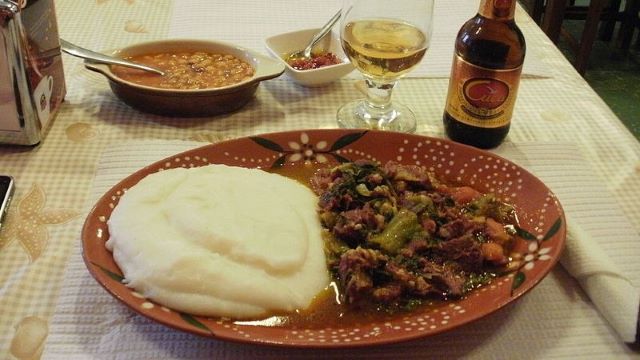By Jonas Loubin – In the vibrant tapestry of Angolan cuisine, there exists a culinary cornerstone that embodies both tradition and sustenance: Funge. This simple yet versatile dish, akin to a stiff porridge, is a staple in Angolan households and an essential accompaniment to the region’s rich array of stews and soups. Join us as we explore the history, preparation, and cultural significance of Funge—a dish that has earned its place at the heart of Angolan dining.
What is Funge?
Funge is a traditional Angolan porridge made from cassava flour or corn flour. Its texture is notably dense and dough-like, providing a substantial base that complements the robust flavors of Angolan stews and soups. While it may seem unassuming, Funge’s role in Angolan cuisine is pivotal. It acts as a blank canvas that absorbs and balances the complex flavors of accompanying dishes.
Ingredients and Preparation
The beauty of Funge lies in its simplicity and adaptability. The basic ingredients are:
- Cassava Flour: Also known as manioc or yuca, cassava flour is made from the starchy root of the cassava plant. It imparts a slightly nutty flavor and creates a smooth, elastic texture when cooked.
- Corn Flour: Alternatively, some recipes use corn flour, which offers a milder flavor and a similar texture.
The preparation of Funge is straightforward but requires attention to achieve the perfect consistency. Here’s a basic method:
- Prepare the Flour: Mix cassava flour (or corn flour) with water to create a smooth, lump-free mixture.
- Cook the Mixture: In a pot, bring water to a boil and gradually add the flour mixture while stirring continuously. This helps prevent lumps and ensures an even texture.
- Stir and Simmer: Reduce the heat and continue to stir the mixture as it thickens. The goal is to achieve a smooth, thick consistency that holds its shape.
The cooking process usually takes around 15-20 minutes, and the Funge is done when it’s firm enough to be served in slices or scoops.
Serving Suggestions
Funge is incredibly versatile and can be served with a variety of dishes:
- Stews and Soups: Funge pairs exceptionally well with rich, hearty stews such as Moamba de Galinha or Caldeirada de Peixe. Its dense texture helps to soak up the flavorful sauces and provide a satisfying contrast to the spiciness of the stews.
- Grilled Meats and Vegetables: For a more substantial meal, serve Funge alongside grilled meats or roasted vegetables. Its mild flavor complements a wide range of dishes and helps to balance out bold seasonings.
Cultural Significance
In Angola, Funge is more than just a side dish; it’s a symbol of family and tradition. It is a common feature at communal meals and celebrations, where it brings people together around the table. The preparation of Funge often involves family members working together, reinforcing bonds and passing down culinary traditions from one generation to the next.
Moreover, Funge holds a special place in Angolan cuisine due to its versatility and role in making meals more filling. It is a testament to the ingenuity of Angolan cooking, where simple ingredients are transformed into a dish that is both comforting and essential.
A Taste of Tradition
Funge offers a unique glimpse into Angolan culture, showcasing how a humble dish can hold profound significance. Its smooth, dough-like texture and ability to complement a wide range of dishes make it a beloved staple in Angolan households.
As you explore the diverse flavors of Angolan cuisine, don’t overlook the importance of Funge. Its unpretentious nature and vital role in balancing out the richness of stews and soups make it an indispensable part of the Angolan culinary experience. So, the next time you find yourself craving something hearty and traditional, consider giving Funge a try. It’s a dish that not only satisfies the appetite but also connects you to the rich cultural heritage of Angola.
Dive into the world of Angolan cuisine with Funge and discover how this simple porridge can transform your dining experience. Bon appétit!

